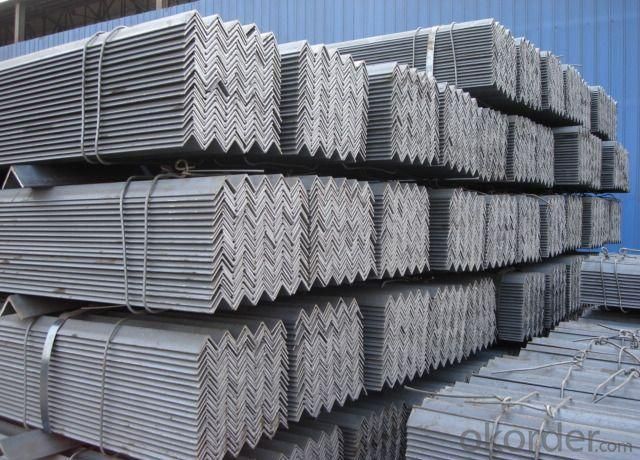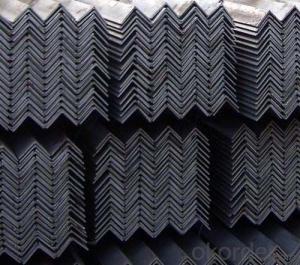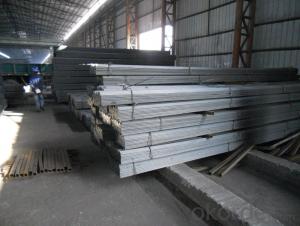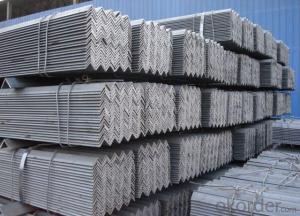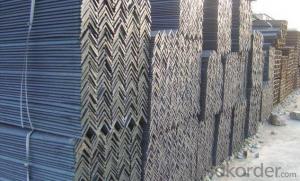Steel Equal Angle with Good Quality 140*140mm
- Loading Port:
- Tianjin
- Payment Terms:
- TT OR LC
- Min Order Qty:
- 100 m.t.
- Supply Capability:
- 15000 m.t./month
OKorder Service Pledge
OKorder Financial Service
You Might Also Like
Specification
Specifications of Steel Equal Angle with Good Quality 140*140mm
1. Invoicing on theoretical weight or actual weight as customer request
2. Length: 6m and 12m
3. Sizes:
| Size(mm) | Mass(kg/m) | Size(mm) | Mass(kg/m) |
| 140*140*10 | 21.488 | 140*140*14 | 29.49 |
| 140*140*12 | 25.522 |
Packaging & Delivery of Steel Equal Angle with Good Quality 140*140mm:
1. Packing: it is nude packed in bundles by steel wire rod
2. Bundle weight: not more than 3.5MT for bulk vessel; less than 3 MT for container load
3. Marks:
-Color marking: There will be color marking on both end of the bundle for the cargo delivered by bulk vessel. That makes it easily to distinguish at the destination port.
-Tag mark: there will be tag mark tied up on the bundles. The information usually including supplier logo and name, product name, made in China, shipping marks and other information request by the customer.
If loading by container the marking is not needed, but we will prepare it as customer request.
FAQ:
Q1: Why buy Materials & Equipment from OKorder.com?
A1: All products offered byOKorder.com are carefully selected from China's most reliable manufacturing enterprises. Through its ISO certifications, OKorder.com adheres to the highest standards and a commitment to supply chain safety and customer satisfaction.
Q2: How do we guarantee the quality of our products?
A2: We have established an advanced quality management system which conducts strict quality tests at every step, from raw materials to the final product. At the same time, we provide extensive follow-up service assurances as required.
Q3: How soon can we receive the product after purchase?
A3: Within three days of placing an order, we will begin production. The specific shipping date is dependent upon international and government factors, but is typically 1 to 2 months.
Q4: How many tons per bundle?
A4: Around 2-3tons
Q5: How to avoid the rust after deliver the goods to the loading port?
A5: We will keep the goods at the port covered with water-proof material
Production flow of Steel Equal Angle with Good Quality 140*140mm:
Material prepare (billet) —heat up—rough rolling—precision rolling—cooling—packing—storage and transportation
Images of Steel Equal Angle with Good Quality 140*140mm:
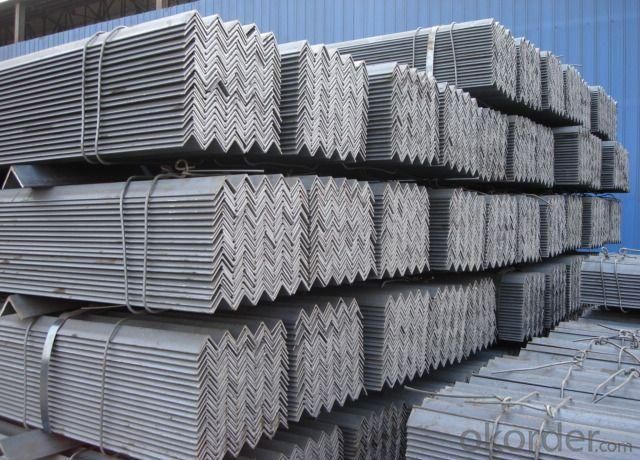
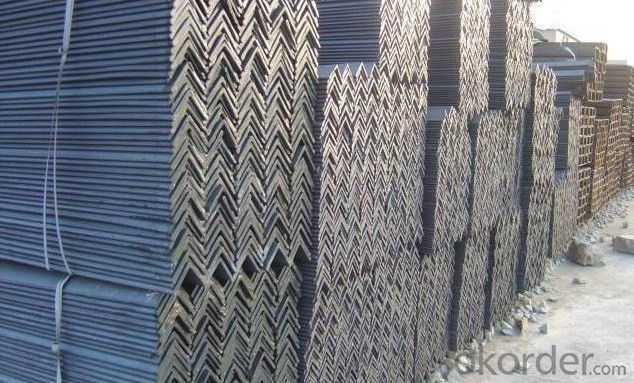
- Q: What are the standard sizes of steel angles?
- The standard sizes of steel angles vary, but some common sizes include 1/2 inch, 3/4 inch, 1 inch, 1-1/4 inch, and 1-1/2 inch.
- Q: Are there any limitations or restrictions on the use of steel angles?
- Yes, there are some limitations and restrictions on the use of steel angles. One limitation is the maximum load capacity they can bear. Steel angles have a specific load-bearing capacity based on their size, shape, and material composition. Exceeding this capacity can lead to structural failure or collapse. Another limitation is related to the angle's installation and fixing methods. Steel angles are typically secured using welding, bolting, or other fastening techniques. The strength and effectiveness of these methods can be influenced by factors such as the quality of the weld or the type of fastener used. It is important to follow proper installation procedures and adhere to recommended guidelines to ensure the angles are securely attached. Furthermore, steel angles may have restrictions on their use in certain environments or applications. For example, steel angles may not be suitable for use in highly corrosive environments without appropriate protective coatings or materials. Similarly, in applications where fire resistance is crucial, steel angles may need to be treated with fire-resistant coatings or replaced with other fire-resistant materials. Additionally, the dimensions and lengths of steel angles can impose limitations on their use. Steel angles are available in various sizes and lengths, and these dimensions should be selected carefully to meet the specific requirements of a project. It is important to consider factors such as the load distribution, span length, and overall structural design to ensure the chosen steel angles are appropriate for the intended application. In summary, while steel angles are versatile and widely used in various construction and engineering applications, there are limitations and restrictions to be aware of. These include load-bearing capacity, installation methods, environmental considerations, and dimensional constraints. It is essential to consult with structural engineers, follow industry standards, and ensure proper planning and implementation to ensure the safe and effective use of steel angles.
- Q: Can steel angles be used in the construction of transmission towers?
- Indeed, transmission towers can incorporate steel angles in their construction. Due to their immense strength, durability, and adaptability, steel angles are frequently employed as structural components in a variety of construction projects. In the realm of transmission tower construction, steel angles are frequently utilized to provide the necessary support and stability. They serve multiple functions, such as bracing and forming cross arms, alongside other crucial structural elements of the tower. These angles are typically crafted from high-strength steel, allowing them to endure the heavy loads and harsh environmental conditions to which transmission towers are subjected. Moreover, steel angles can be effortlessly fabricated, connected, and erected, rendering them an economically viable choice for transmission tower construction.
- Q: Are steel angles suitable for architectural sculptures or installations?
- Yes, steel angles can be suitable for architectural sculptures or installations. Steel angles are versatile and durable, making them a popular choice for creating intricate and visually appealing structures. Their geometric shape allows for interesting angles and shapes to be formed, adding a unique aesthetic to architectural sculptures or installations. Additionally, steel angles can be easily welded or attached together, providing flexibility in design and construction. The strength and stability of steel angles also make them suitable for outdoor installations, as they can withstand various weather conditions. Overall, steel angles offer architects and artists a reliable and versatile material to create innovative and striking sculptures or installations.
- Q: How do you calculate the buckling capacity of a steel angle?
- To calculate the buckling capacity of a steel angle, you need to consider several factors. Firstly, determine the effective length of the angle. This is the distance between points of rotation or points of restraint. Next, calculate the slenderness ratio, which is the effective length divided by the radius of gyration. The radius of gyration is a measure of how the steel angle's cross-sectional area is distributed around its centroid. Once you have the slenderness ratio, you can refer to design codes or standards, such as the American Institute of Steel Construction (AISC) Manual, to find the critical buckling stress or load for the given slenderness ratio. These codes provide tables or formulas to determine the critical buckling capacity based on the angle's dimensions and material properties. It is important to note that the buckling capacity of a steel angle depends on the boundary conditions, end fixity, and the method of buckling, whether it is flexural or torsional. Therefore, understanding the specific loading and boundary conditions is crucial in accurately calculating the buckling capacity.
- Q: How are steel angles protected during transportation and storage?
- To ensure the preservation and quality of steel angles during transportation and storage, various measures are taken. One commonly employed method involves the application of a protective coating or paint to the surfaces of the steel angles. This coating acts as a barrier, shielding the angles from moisture and preventing the occurrence of rust and corrosion. Moreover, plastic wrapping or tarp covering can be utilized to safeguard the angles against dirt, dust, and other contaminants. During transportation, the risk of shifting or falling is minimized by securing the steel angles in bundles or arranging them in a manner that reduces such hazards. Additionally, pallets or skids may be employed to facilitate handling and prevent direct contact with the ground. When stored, it is crucial to keep the steel angles in a well-ventilated and dry area in order to prevent the accumulation of moisture. Furthermore, proper labeling and handling instructions play a vital role in preventing mishandling or damage during transportation. This entails the use of appropriate lifting equipment and avoidance of rough handling that could potentially lead to bending or deformation. By implementing these protective measures, the integrity and quality of steel angles can be upheld throughout the transportation and storage processes, ensuring their readiness for use.
- Q: Can steel angles be bolted together?
- Yes, steel angles can be bolted together. Bolting steel angles is a common method of joining them to create various structures or frameworks.
- Q: How do you determine the appropriate thickness of a steel angle for a specific application?
- To calculate the suitable thickness of a steel angle for a specific purpose, several factors must be taken into consideration. Firstly, it is crucial to comprehend the load or weight that will be exerted on the steel angle. This includes both the static load, which refers to the continuous weight the angle will bear, and the dynamic load, which signifies any intermittent additional force. The magnitude of the load will determine the strength requirements of the steel angle. Secondly, the length of the steel angle needs to be accounted for. Longer angles will experience more deflection and bending, thus necessitating a thicker angle to ensure adequate rigidity and prevent deformation under the load. Another critical factor to consider is the type of steel being utilized. Different steel grades possess varying strength properties, and the appropriate thickness will depend on the specific grade. It is essential to consult the material specifications and standards to ensure the selected steel angle meets the necessary strength and durability criteria for the intended application. Additionally, the support conditions and the method of attachment should be taken into account. The manner in which the steel angle is connected to other structural elements will impact its load-bearing capacity. If the angle is bolted or welded to other components, its thickness must be selected to suit the particular connection method and accommodate any additional stresses induced during the attachment process. Lastly, it is important to adhere to any applicable industry standards, codes, or regulations when determining the suitable thickness of a steel angle. These standards often provide guidelines or calculations for selecting the correct size and thickness based on the intended application, load, and other design factors. In conclusion, determining the appropriate thickness of a steel angle for a specific application necessitates considering factors such as the load magnitude, length, steel grade, support conditions, and attachment method. Consulting material specifications, industry standards, and seeking professional advice can ensure that the chosen steel angle meets the required strength and durability specifications.
- Q: How do steel angles perform in terms of sound insulation?
- Steel angles are not known for their sound insulation properties. Due to their rigid and dense nature, steel angles have little ability to absorb or dampen sound waves. This means that they do not provide significant sound insulation on their own. However, when used in combination with other materials such as acoustic insulation, steel angles can contribute to the overall sound insulation of a structure. Additionally, the thickness and design of the steel angles can also have an impact on their sound insulation performance. Overall, while steel angles may not offer exceptional sound insulation properties, they can still play a role in improving the overall soundproofing of a building when used in conjunction with other soundproofing materials.
- Q: How do you calculate the moment of inertia of a steel angle?
- To calculate the moment of inertia of a steel angle, you need to know the dimensions and shape of the angle. The moment of inertia measures an object's resistance to changes in rotation, and it is essential in engineering and physics calculations. The moment of inertia, denoted by I, can be calculated using the formula: I = (b * h^3) / 12 Where: - I is the moment of inertia - b is the base width of the steel angle - h is the height or leg length of the steel angle This formula assumes that the steel angle is a uniform, solid object. If the steel angle has varying dimensions or holes, the calculation becomes more complex and may require additional formulas or numerical methods. It is important to note that the moment of inertia depends on the axis of rotation. The formula mentioned above calculates the moment of inertia about the centroidal axis, which is the axis passing through the center of mass of the angle. If you need to calculate the moment of inertia about a different axis, you may need to use the parallel axis theorem or other advanced techniques. In practice, it is often helpful to consult engineering handbooks or reference materials specific to steel angles as they may provide more detailed formulas or tables that take into account specific design characteristics and dimensions.
Send your message to us
Steel Equal Angle with Good Quality 140*140mm
- Loading Port:
- Tianjin
- Payment Terms:
- TT OR LC
- Min Order Qty:
- 100 m.t.
- Supply Capability:
- 15000 m.t./month
OKorder Service Pledge
OKorder Financial Service
Similar products
Hot products
Hot Searches
Related keywords



